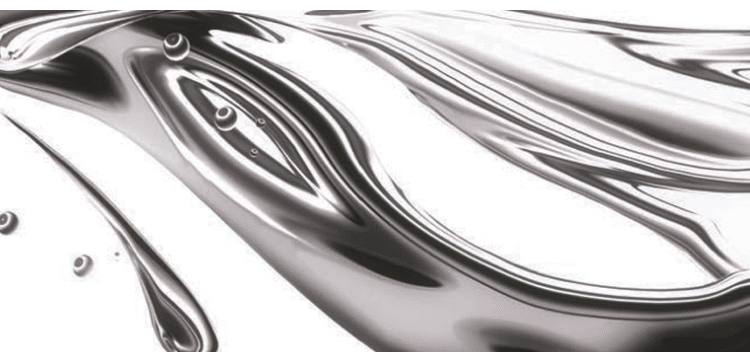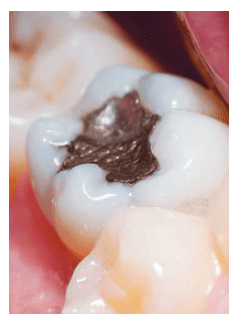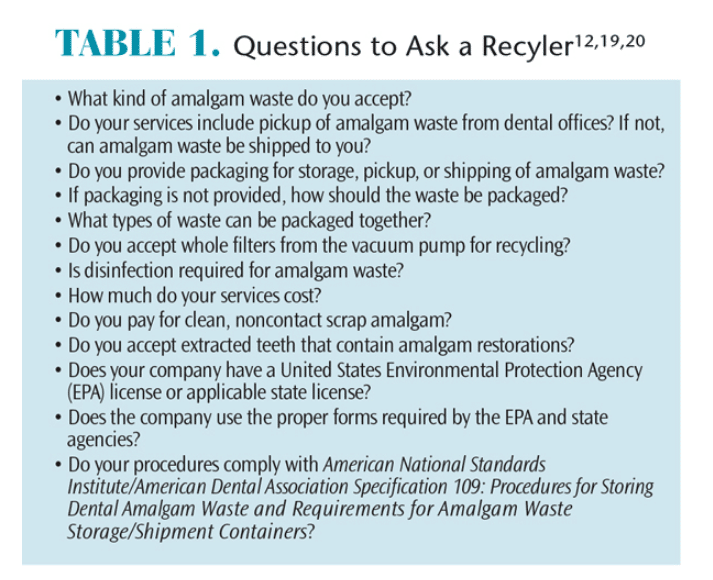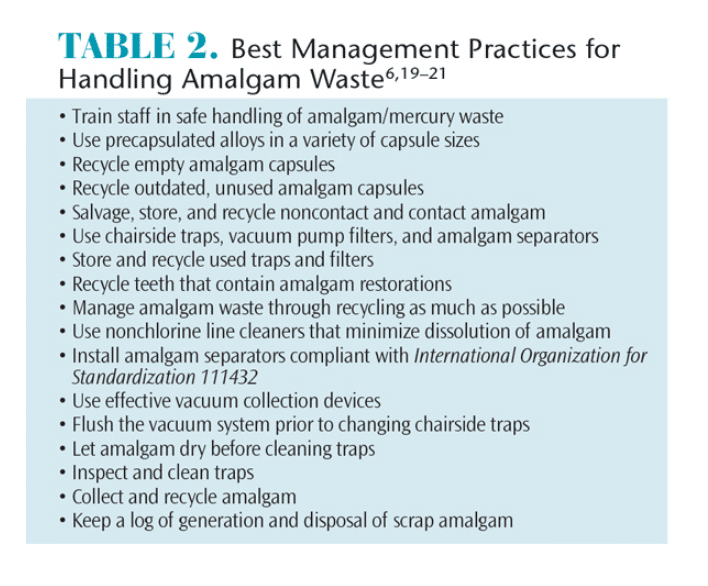 ZFFOTO / ISTOCK / THINKSTOCK
ZFFOTO / ISTOCK / THINKSTOCK
Minimize Amalgam Waste
Dental practices must follow best management practices to ensure the safe handling and disposal of amalgam waste.
This course was published in the June 2016 issue and expires June 30, 2019. The author has no commercial conflicts of interest to disclose. This 2 credit hour self-study activity is electronically mediated.
EDUCATIONAL OBJECTIVES
After reading this course, the participant should be able to:
- Explain the environmental impact of amalgam waste/mercury.
- Identify the primary routes amalgam waste/mercury can be introduced into the environment.
- List the best management practices for handling amalgam waste.
- Discuss the steps to minimize amalgam waste in a dental facility.
Dental amalgam has been used successfully in dentistry for more than 150 years. In recent decades, however, resin materials have become increasingly popular due to their high esthetic quality and ability to mechanically bond to natural teeth, in addition to concerns about the health and environmental effects of the mercury found in amalgam.
The American Dental Association (ADA) Council on Scientific Affairs and the United States Food and Drug Administration (FDA) note that evidence shows amalgam is a safe and effective restorative option for patients.1 Dental amalgam is considered an effective restorative material due to its compressive strength, marginal integrity, suitability for large occlusal surfaces, and durability.2 However, dental amalgam does release low levels of mercury vapor. The highest concentrations of mercury vapor occur immediately after a restoration is placed or when an amalgam restoration is removed. Little or no mercury vapor is detectable at other times.3
Dental amalgam is a combination of metals that typically includes silver, tin, copper, zinc, and mercury. Silver increases the strength of amalgam, decreases creep, and is largely responsible for its luster when polished. Amalgam is approximately 50% mercury and is necessary to wet the particles for amalgamation of the metals. The advantages of amalgam restorations (Figure 1) include biological compatibility, ease of adaptation and placement, ease of replicating a tooth’s anatomy, ease of polishing, and low cost. Disadvantages of the filling are poor esthetics, thermal conductivity, the need for sufficient bulk to support amalgam margins, and potential discolorization of proximate hard and soft tissues.4 Another disadvantage is the creation of mercury waste, which poses an environmental hazard.

Dental mercury is most often introduced into the environment when new amalgam restorations are placed or when old amalgam restorations are removed. Dental offices typically use some type of filtration system consisting of conventional particulate filters and gravity-based traps to reduce the amount of mercury solids that would otherwise pass into sanitary sewer systems. However, wastewater amalgam continues to receive scrutiny from regulators because of national, state, and local initiatives to reduce or eliminate the discharge of mercury and mercury-containing pollutants into the environment. Mercury is a health concern because it is considered a persistent bioaccumulative toxin that can negatively affect the health of wildlife and humans. Once mercury enters the water or soil, it is likely to reach the food chain. Fetuses, infants, and children are the most vulnerable to mercury exposure.5–7
ENVIRONMENTAL CONSIDERATIONS
Environmental laws and regulations were created to address other pollution and public safety concerns rather than to specifically regulate amalgam. However, the implementation of these laws has impacted dental facilities.8
The US Environmental Protection Agency (EPA) estimates there are approximately 120,000 dental facilities that use amalgam and discharge wastewater into publically owned treatment works (POTWs).6 It is difficult to measure the actual amount of amalgam waste that is discharged from dental offices into sewage systems but it remains an area of concern. Estimates regarding the amount of mercury from dental amalgams discharged vary from 3.7 tons to 6.5 tons per year.6,9 The main problem is that mercury does not degrade, but can change from one form to another, depending on the environment. In bodies of water, microorganisms can convert some forms of mercury to methylmercury, which is highly toxic. Aquatic organisms and fish thereby acquire methylmercury, which accumulates and persists in the food chain.
PRIMARY ROUTES TO THE ENVIRONMENT
Amalgam particles have four primary routes to the environment: sewage grit, sewage sludge, discharge of treated wastewater into surface waters, and regular or regulated medical-waste pathways. Mercury that reaches waterways can accumulate in the tissues of fish. Frequent consumption of large fish, such as tuna, can adversely affect a developing human nervous system.
Sewage treatment plants typically process sewage sludge and sell it as fertilizer that can be introduced into surface waterways via runoff. Amalgam in extracted teeth can be mistakenly mixed with infectious waste and, if incinerated, the mercury can volatize and release into the atmosphere. Extracted teeth that contain amalgam should be collected and packaged in an airtight container for recycling. Educational facilities where students learn dental restorative procedures should recycle plastic typodont teeth that contain amalgam restorations. If amalgam is discarded as part of the regular trash stream, it usually goes to landfills where it can leach into the groundwater or be incinerated—potentially releasing mercury vapor.10
Proper clinical management of waste amalgam includes appropriate and routine maintenance of filters and chairside traps. Such items capture the majority of waste amalgam. Most systems can separate particles as small as 0.4 mm to 0.7 mm. A combination of chairside traps and vacuum filters can result in the removal of 40% to 80% of amalgam particles.6
Contact amalgam is amalgam that has been exposed to the oral cavity and is considered biocontaminated. Recovered contact amalgam should be stored in an airtight container and labeled “contact amalgam.” Noncontact amalgam is any amalgam that is not biocontaminated, including expired or defective amalgam. It should be stored in an airtight container and labeled “noncontact amalgam.”7 Because of the difficulty in effectively removing all amalgam particles from reusable traps without spilling particles, disposable traps are recommended. The vacuum system should be flushed at the end of the day with a disinfectant solution and before changing the trap. Allowing the amalgam particles to dry before removing the trap is recommended to facilitate removal. Visible amalgam can be removed from a trap with forceps or by tapping the dried amalgam into a properly labeled container that is kept tightly sealed. Disposable traps should be removed and placed in a properly labeled container and should not be rinsed or washed in a sink so as to keep particles out of the sanitary sewer system.
Fine filters (eg, 100 mesh, 149 micrometers) require frequent cleaning or replacement, but they are more effective in catching smaller particles compared with a size 40 (420 micrometers) mesh trap. Dental personnel should follow all manufacturer guidelines regarding cleaning or changing filters and traps. Personal protective equipment (PPE), such as safety glasses, gloves, and masks, should be worn when maintaining or changing filters and traps.11 Traps or filters contaminated with amalgam should never be disposed of with normal rubbish or as infectious waste. Empty amalgam capsules should also not be disposed of in the garbage or incinerated.12
EFFLUENT LIMITATION GUIDELINES AND STANDARDS
In 2007, the ADA updated its best management practices to include a recommendation for the use of amalgam separators.6 Efficient separators generally have a removal efficiency of 95% or higher. In December 2008, the EPA signed a memorandum of understanding with the ADA to establish and monitor the effectiveness of a voluntary dental amalgam discharge reduction program.13 The purpose was to have dental offices voluntarily install and properly maintain amalgam separators and recycle collected amalgam waste.6 In September 2014, the EPA proposed Effluent Limitation Guidelines and Standards for the Dental Category. The guidelines include pretreatment standards under the Clean Water Act for discharges of pollutants into POTWs from existing and new dental facilities. The final standards are scheduled for release sometime in 2016. These standards will require efforts to reduce and minimize amalgam waste.14 It is hoped that compliance with the proposed rule will reduce the annual discharge of dental-related waste metals to POTWs by 8.8 tons.14 Studies show that approximately half of mercury discharges destined for POTWs originate in dental offices. This makes dental offices the largest single source of waste mercury for POTWs.
The new standards require dental facilities to reduce mercury discharges to achievable levels through the use of amalgam separators and best management practices (a series of amalgam waste handling and disposal guidelines).14 Dental facilities should check local, state, and federal regulations to ensure compliance with all requirements related to amalgam-containing effluents.
COSTS TO REDUCE WASTE
Implementing a best management practices program for amalgam waste includes sustaining the costs of purchasing and maintaining amalgam separators as well as amalgam waste recycling fees. There are three typical options for acquiring amalgam separators: purchasing and maintaining; purchasing and contracting with a company for maintenance; and leasing a separator with maintenance and service included in the fees. Installation costs can range from hundreds to thousands of dollars depending on the size of the dental facility. The size of the separator depends on the number of dental operatories. How frequently the filters and traps need to be cleaned or replaced depends on a facility’s wastewater flow rate.6 Annual recycling costs run in the hundreds-of-dollars range and vary based on the amount of waste produced and how the recycler receives the waste.
AMALGAM SEPARATORS
Amalgam separators are designed to remove amalgam waste particles missed by chairside traps and filters. Two standards are used to evaluate the efficiency of amalgam separators. The International Organization for Standardization (ISO) Standard 11143 and the EPA’s Environmental Technologies Verification Program.15 The ISO Standard requires amalgam separators to remove at least 95% of amalgam particles by weight. Amalgam particles in dental wastewater can range from smaller than 0.45 micrometers to larger than 3 mm.
Highly efficient amalgam separators may use several techniques to remove various-sized particles from dental waste water—namely sedimentation, filtration, centrifugation, or ion exchange. Sedimentation units reduce the speed of wastewater, allowing the amalgam particles to settle out via gravity. Filtration units remove both fine and coarse particles. Centrifuge units separate amalgam particles using centrifugal force. Combination units use two or more techniques to remove fine and suspended amalgam particles of mercury.16,17
The combination of chairside traps, filters, and separators has been shown to achieve 99% removal rates.16 Separators require maintenance, but this varies depending on the type.18
RECYCLING AMALGAM WASTE
Recycling dental amalgam waste is a part of best management practices that all dental facilities should follow. Recycling is a way to prevent mercury from being introduced to the environment and safely recycled for use in new products. Amalgam recycling companies may not accept all types of waste. Thus, a recycling company should be hired prior to recovering amalgam waste so the company’s specific handing requirements can be met.
Standard precautions should always be observed when handling amalgam. Amalgam waste should be stored in a covered plastic container and labeled “Amalgam for Recycling,” or as directed by the recycler. Dental facilities should keep a log of scrap amalgam waste to serve as documentation of proper disposal.
When identifying a recycling service, inquire if the company complies with federal and state laws and the American National Standards Institute/ADA specification 109: Procedures for Storing Dental Amalgam Waste and Requirements for Amalgam Waste Storage/Shipment Containers.19,20 For the protection of dental personnel, only precapsulated amalgam mixed in an amalgamator is recommended to minimize contact and spills. Table 1 lists sample questions to ask a recycling company.12,19,20
For the protection of dental personnel, only precapsulated amalgam mixed in an amalgamator is recommended. Triturate only the amount of amalgam needed for the specific restoration to minimize waste. If only a small amount of amalgam is needed, mix a one-spill capsule instead of a two-spill capsule. Emptied capsules should be placed in a separate wide-mouthed, airtight container labeled, “Amalgam Capsule Waste for Recycling.” When the container is full, contact the recycling company. Bulk mercury is not recommended in the dental environment. Never use bleach to clean wastewater systems that may be contaminated with mercury.
Dental personnel who may encounter amalgam or amalgam waste should be trained in the safe handling and proper disposal of mercury-containing materials. Workers who handle mercury are protected under the Occupational Safety and Health Administration Hazard Communication Standard and require training and information regarding the handling of this potentially hazardous material.6 Table 26,19–21 lists best management practices for amalgam waste handling, while Table 36,12,19–21 provides a list of “don’ts” when handling amalgam.
CONCLUSION
Managing amalgam waste requires knowledge of and commitment to best practices for all dental team members. The ADA has determined that the best approach to handling the mercury waste disposal problem is for all dental facilities to implement best practices. The voluntary approach was well-received by environmental regulators.
The ADA has worked with environmental regulators to develop and update guidelines and recommendations for managing amalgam waste; distribute literature to enhance understanding regarding waste management; provide training programs to improve communication between dental groups and environmental regulators; and actively promote recycling to minimize mercury waste in the environment.
Ongoing communication and training with local, state, and federal entities to ensure current best practices are instituted will help minimize mercury in the environment.
References
- American Dental Association. Statement on Dental Amalgam. Available at:?ada.org/en/about-the-ada/ada-positions-policiesandstatements/ statement-on-dental-amalgam. Accessed May 21, 2016.
- United States Department of Health and Human Services. Dental Amalgam: A Scientific Review and Recommended Public Health Service Strategy for Research, Education and Regulation. Available at: web.health.gov/environment/amalgam1/ct.htm. Accessed May 21, 2016.
- Tokar EJ, Boyd WA, Freedman JH, Waalkes MP. Toxic effects of metals. In: Klaassen C, ed. Casarett & Doull’s Toxicology: The Basic Science of Poisons. 8th ed. New York: McGraw-Hill Medical; 2008:981–1030.
- Gladwin M, Bagby M. Clinical Aspects of Dental Materials. 4th ed. Baltimore: Lippincott Williams & Wilkins; 2013.
- Pichay TJ. Dental amalgam: Regulating its use and disposal. J Calif Dent Assoc. 2004;32:580–582.
- Environmental Protection Agency. Health Services Industry Detailed Study: Dental Amalgam. Available at: epa.gov/sites/production/files/201506/ documents/dental-amalgam-study-2008.pdf. Accessed May 21, 2016.
- Environmental Protection Agency. Dental Effluent Guidelines. Available at:?epa.gov/eg/dental-effluent-guidelines. Accessed May 21, 2016.
- Pichay TJ. Dental amalgam: regulating its use and disposal. J Calif Dent Assoc. 2004;32:580–582.
- American Dental Association. Summary of Recent Study of Dental Amalgam in Wastewater. Available at:?ada.org/~/media/ADA/Member% 20Center/FIles/topics_amalgamwaste_summary.pdf?la=en. Accessed May 21, 2016.
- JEA. Water Quality Report. Available at:?jea.com. Accessed May 21, 2016.
- Comisi KL. Guidelines to Minimize Exposure to Mercury and Mercury Vapor. Available at: dentalaegis.com/ida/2011/12/amalgam-management. Accessed May 21, 2016.
- Environmental Protection Agency. Recycling Dental Amalgam Waste and Other Best Management Practices for Your Dental Office. Available at:?epa.gov/region02/waste/mercury/ dental.htm. Accessed May 21, 2016.
- Environmental Protection Agency. Water Science. Available at:?epa.gov/science-and-technology/water-science. Accessed May 21, 2016.
- Environmental Protection Agency. Effluent Limitations Guidelines and Standards for the Dental Category. Available at:?epa.gov/sites/production /files/201506/documents/dental-category-factsheet_proposed_rule_2014.pdf. Accessed May 21, 2016.
- International Standards Organization. ISO 11143:1000, Dentistry: Amalgam Separators. Available at:?iso.org/iso/iso_catalogue/catalogue_tc/ catalogue_detail.htm?csnumber=42288. Accessed May 21, 2016.
- McManus KR, Fan PL. Purchasing, installing and operating dental amalgam separators. J Am Dent Assoc. 2003;134:1054–1056.
- Sarrett DC. Dental amalgam separators. ADA Professional Products Review. 2007;2(4):1–5.
- Fan PL, Batchu H, Chou HN, Gasparac W, Sandrik J, Meyer DM. Laboratory evaluation of amalgam separators. J Am Dent Assoc. 2002;133:577–584.
- California Dental Association. Dental Amalgam: Public Health and the Environment. Available at:? cda.org/Portals/0/pdfs/policy_statements/issue_amalgam.pdf. Accessed May 21, 2016.
- American Dental Association. Best Management Practices for Amalgam Waste. Available at:?ada.org/~/ media/ADA/Member%20Center/FIles/topics_amalgamwaste_brochure.ashx. Accessed May 21, 2016.
- American Dental Association. ANSI/ADA Specification No. 109. Procedures for Storing Dental Amalgam Waste and Requirements for Amalgam Waste Storage/Shipment Containers. Available at:?ada.org/en/science-research/dentalstandards/dental-products/products-standards-technical-specifications-and-technical-reports. Accessed May 21, 2016.
From Dimensions of Dental Hygiene. June 2016;14(06):60,63–65.



